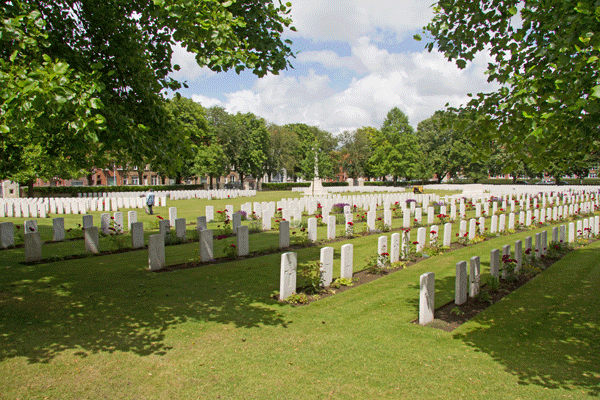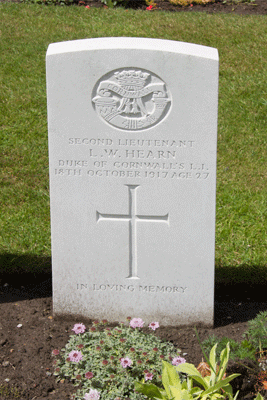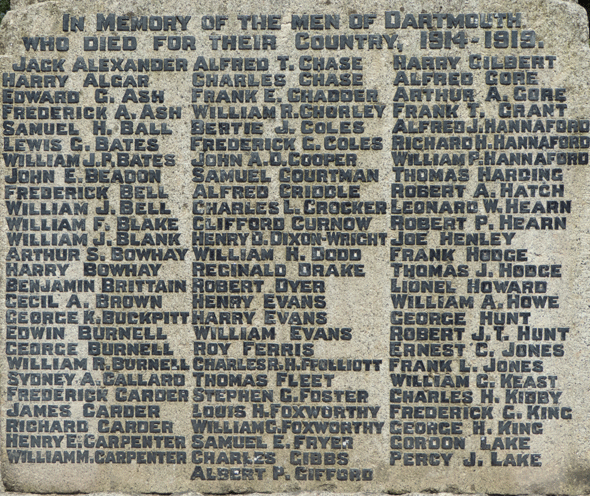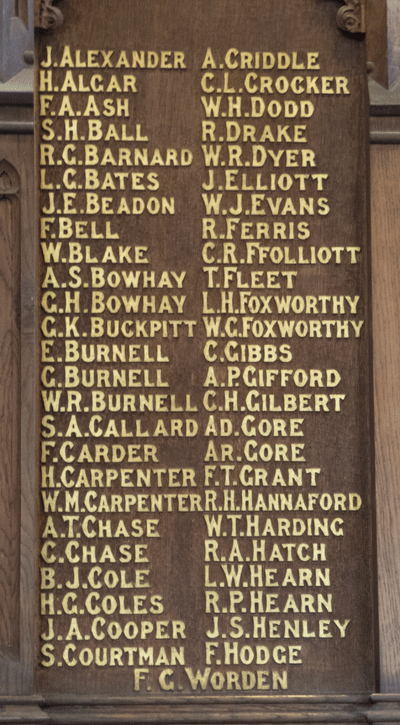Leonard Webb Hearn
Family
Leonard Webb Hearn was born in Dartmouth on 19th July 1890. He was the youngest child of John Emanuel Hearn and his wife Elizabeth Prowse, and was baptised at St Saviours, Dartmouth, on 28th March 1895. For Leonard's family background, see the story of his elder brother, Robert Prowse Hearn, killed on the Somme in 1916.
The 1911 Census recorded Leonard, age 20, living at home with his parents and several of his brothers and sisters. He was a "law clerk in a solicitor's office", and from information published in the Dartmouth Chronicle at the time of his death (see below), we know that he worked for W Stanley Richards, a solicitor with branches in Paignton and Dartmouth. Before the war Leonard played a full part in Dartmouth's political, sporting and social life, as recorded a few weeks after his death in a tribute published in the Chronicle from his friend Thomas Caston. Thomas Caston had worked for the Chronicle before the war and joined up with Leonard in 1915.
Non Sibi Sed Patriae!
No better tribute could surely be paid to the memory of the gallant dead than this. The morning's mail in France a few days since brought me the sad news of the death in action of one whom I was proud to number among my friends - 2nd Lieut Leonard W Hearn. One more Dartmouth hero has been called to his rest, and his native town mourns its loss.
Blest with a bright and happy disposition, Leonard Hearn, as we best remember him, had a wide circle of friends in the old borough. Whether at work, or in the pursuit of his varied pastimes, he invariably displayed the fullest measure of energy, and he was a good, keen, and fair sportsman.
Out here in the vortex of war one's thoughts revert to the halcyon days of peace, and one pictures the young officer indulging in an early morning dip at Castle Cove with other members of Dartmouth Amateur Swimming Club, later in the day, batting or bowling for his old love the Kingswear Cricket Club, or maybe enjoying a run with the Britannia Beagles, or a motor cycle ride through Devon's lovely lanes. In fact all forms of healthy recreation had in him a warm patron, and nothing afforded him greater pleasure on a winter's evening than a hundred up in the billard room of Dartmouth Constitutional Club. In the palmy days of Dartmouth Association Football Club, 2nd Lieut Hearn scored many a goal for his team both on the home ground at Swannaton, and at away matches.
In politics he was a staunch Unionist, and he did yeoman service for the "Dart" Habitation of the Primrose League during the period of his secretaryship. His active association with imperial politics indeed extended back to the formation of the Junior Imperial Constitutional League, he being one of the earliest, if not the first, local secretaries. As the secretary to Dartmouth Commercial Association he rendered good service to the borough, and none but his most intimate friends realised the large proportion of his leisure hours sacrified in the interests of the Association.
The outbreak of war found him fully alive to the responsibilities of citizenship, and as soon as family and other circumstances permitted - he was the youngest son - he, as many another Dartmothian has done, cast aside all his future prospects, promising as they were, and stepped boldly forth to do his bit to help the old country to subdue a brutal foe.
Service
Leonard Hearn volunteered late in 1915 under the "Derby scheme", the Government's final attempt to encourage men to volunteer before the introduction of conscription. He and Thomas Caston were listed amongst those "joining the Army Reserve" in a list published in the Dartmouth Chronicle of 24th December 1915. Those joining at this stage were able to chose whether to serve immediately or defer service until mobilised - Leonard evidently chose the latter.
Exactly when Leonard was mobilised is not known, but between 1st-4th February 1916 he joined the 28th London Regiment (Artists Rifles), having been selected for officer training. The Artists Rifles were a Territorial Force unit; highly fashionable, it attracted many recruits from the professions as well as from artistic and creative occupations (from which the unit had originated in the 19th century). The unit was sent to France at the end of October 1914 and became almost immediately a Training Corps for officers in the field. Sir John French (later Earl French) said at a later reunion:
I shall never never forget the first visit I paid to the Artists after they landed in France, or the wonderful impression they left on my mind of the possibilities which were in that Corps of furnishing a want which was so terrible to all of us at that time, the supply of officers ... Just at the period I am speaking of we had suffered fearful casualties, and the proportion of losses in officers was higher than in any other rank, and it was going on every day ... The Artists became the model for, and an example to, that large number of training establishments all over France, which to the end of the war turned out officers with the utmost speed and the utmost efficiency.
By the end of the war the Artists Rifles had provided over 10,000 officers to other regiments, and also trained several thousand cadets from other regiments. In the latter part of the war it also maintained a fighting Battalion.
After ten months training with the Artists Rifles, Leonard was commissioned 2nd Lieutenant in the Devonshire Regiment on 19th December 1916 (London Gazette 9th January 1917), joining the 3rd Battalion for further training. Four months later he was attached to the 6th Battalion Duke of Cornwall's Light Infantry (London Gazette 1st May 1917).
The 6th Battalion DCLI had been raised following the outbreak of war and went to France in 1915. In April/May 1917, they were in the Arras sector. The Battalion's War Diary does not seem to report his arrival, but by 8th June 1917, according to the Dartmouth Chronicle, Leonard was in hospital at Le Treport, France, "suffering from trench fever". However, the newspaper reported that: "A letter received from him yesterday states that he is progressing favourably."
For most of the summer the 6th Battalion was out of the line in training at Bus-les-Artois Rest Camp, in the Somme area (now well behind the front line) and was then brought further north to the area around Bailleul, as part of the build-up for the Flanders offensive. As the Third Battle of Ypres began on 31st July 1917 they were still near Bailleul. For the background to this offensive, see the story of William John Farrow Bates, of the 2nd Devons, killed on the first day while attacking east of the city.
They were not involved in the fighting during the first couple of weeks, but on 14th August, according to the War Diary:
.... a large carrying party comprising 16 officers and 500 other ranks under the command of Major C F Miller DSO paraded at 12 noon ... and proceeded to the Infantry Barracks Ypres [where] they were met by an Officer and Guides of a Special RE Company who conducted the different parties to certain Dumps and supervised the carrying of Munitions from thence to the places they required same. Whilst performing this duty the parties were caught by a barrage put down by the enemy somewhere in the vicinity of Sanctuary Wood.
The Special Companies of the Royal Engineers were responsible for gas weapons and the "munitions" were gas cylinders. In the circumstances it is perhaps surprising that casualties on this occasion were relatively few: one man killed, and one missing, with ten wounded.
After this the Battalion was brought further forward and by 17th August was camped at Dikkebus, south-west of Ypres, "standing by for orders". On 19th August, after Divine Service, the officers visited the part of the front line they were shortly to take over, and, with NCOs, also visited "Model Trenches in sand and cement to give them an idea of the ground they were going to fight on". Attacks were duly practised. How effective this was, given the prevailing conditions on the battlefield and what they encountered shortly afterward, is not clear. They went into the front line on the night of 20th/21st August, north of the Menin Road. Though the Battalion's War Diary makes no reference to it, the weather at this point made conditions terrible.
They were not involved in a general attack but in what was later called a "minor operation", part of a series of assaults attempted during the latter part of August to improve the initial positions gained earlier. Peter Hart describes this period:
A pattern of desperate, unimaginative assaults, crushing German counter-attacks and an overwhelming sense of despair began to afflict the British campaign in Flanders. Like his men, [General] Gough [of Fifth Army] was floundering, hamstrung by factors beyond his control ...The gains were minimal, the casualties high, in near-futile assaults launched on 10 August, 16 August and 22 August.
The 6th Battalion attacked just to the north of the Ypres-Menin Road, between the southern edge of Glencorse Wood on the left and the northern edge of Inverness Copse on the right. The account in the Battalion's War diary provides a catalogue of misfortune.
Assembly was delayed because "B" Company, sent off the previous night to fetch water and rations, got lost and were late; this prevented the other companies reaching their assembly position on time. An enemy aeroplane observed the whole Battalion lining up in the open, and fired on them, which "caused some confusion", as the CO's report put it. Nonetheless the attack went ahead, but due to very heavy enemy machine gun fire from both flanks, the leading companies completely lost touch with the barrage, and stopped. However, a tank emerging from Inverness Copse "performed most valuable service"; one enemy strong point was destroyed by the tank, and another, by a strong bombing party.
Nonetheless, any further advance was prevented by continuing heavy machine gun fire, so overnight the Battalion consolidated the position they had reached. Reinforcements of two companies of the Kings Own Yorkshire Light Infantry were sent up, though only one company arrived, the other, apparently, having got lost. Early the next morning the attack was then resumed (the report in the Battalion War diary does not give a time) in conjunction with a tank attack. But this coincided with an enemy counter attack, through Inverness Copse, though pursued with "little energy", according to the CO's report of the action.
The tank attack then broke down; although four were detailed for the attack, one had fallen down an embankment while moving up; one was hit by enemy fire; and another developed engine trouble. The remaining tank, however, made a substantial contribution to holding back the enemy counter-attack, before it withdrew with the crews of the other tanks.
Throughout the night of 23rd/24th August, they held their position, but were heavily shelled. A second enemy counter-attack was launched at 4.30am, and was effective in pushing the Battalion back to its starting point. By this time, there were insufficient troops to attempt to regain the lost ground, without risking the original front line as well; and furthermore, a requested barrage was not effectively targeted or coordinated with the troops on the ground. No further attempt was made to advance - the Battalion was relieved that night. Casualties were high - seven officers and 55 men were killed, with 28 men missing; eight officers and 252 men were wounded.
Leonard somehow survived this - perhaps he had been fortunate, and was detailed for duty in the rear. Perhaps he was even luckier, and was at this time on leave in Dartmouth - when news of his death reached Dartmouth in late October, it was noted that "it was only a couple of months ago that he was home here on ten days leave" (see below). After the August attack, the Battalion went into rest and training for some time, returning to hold the front line near Messines a month later, on 24th September. By this stage, another phase in the Third Battle of Ypres had begun.
On 25th August, General Haig transferred responsibility for planning the next stage of the offensive to General Plumer, commanding Second Army, from General Gough, commanding Fifth Army. General Plumer first wanted three weeks preparation, before a series of "bite and hold" attacks, in four steps, each followed by a six-day pause, to allow for consolidation, defence against any counter-attack, and preparation of the next step.
The first step, now called the Battle of Menin Road, had begun on 20th September, in good weather, and - broadly - achieved its objectives. After the requisite six days, the next step, now called the Battle of Polygon Wood, was launched on 26th September. Although an attack by the Germans intended to disrupt preparations had some success, the front was pushed forward another 1000-1250 yards. In the third step on 4th October, the Second Army attacked the Broodseinde Ridge, the Zonnebeke Spur and Gravenstafel Spur, whilst the Fifth Army alongside them to the north moved on Poelcappelle. Dartmouth suffered several casualties from this attack.
But by the time of the Battle of Poelcapelle, begun on 9th October, the weather had once again worsened, and the conditions became, in Peter Hart's words:
... a hell on earth ... The British were caught in a bind. Stuck in front of the Passchendaele Ridge, either they could go forward, or they could go back to the Pilckem Ridge. Tactically they could not stay in the swamps down below the German lines... Some meagre advances were made ... but overall the Battle of Poelcapelle was an utter failure.
The desperate circumstances led even General Plumer, under pressure from General Haig, to abandon principles which had brought success only a few weeks earlier. The First Battle of Passchendaele, on 12th October 1917, was a disaster, after which it was decided to postpone any further attack until the weather had improved. Responsibility for the next phase was given to the newly arrived Canadian Corps, whose General, Sir Arthur Currie, wanted careful and extensive preparation. The Second Battle of Passchendaele was not launched until 26th October 1917.
In the meantime, knowing that a further attack was likely, German forces subjected every part of the Ypres salient, both the front line and all support areas, to near-continuous and extremely heavy shelling. On the night of 15th/16th October, the 6th Battalion, having been out of the line for just under three weeks, was brought back in, near Sanctuary Wood. The 10th Battalion Durham Light Infantry, with "B" Company of the 6th Cornwalls, was forward, holding the front line itself, while the other companies of the 6th Cornwalls were involved in carrying rations up to them, in parties of 20 under an officer. There was near continuous heavy shelling with gas and high explosives, killing four men and wounding seven. The following day was similar, but casualties were heavier: eight men were killed and three missing, with two officers and twelve men wounded.
Death
This pattern of work continued on 18th October, before 6th Cornwalls moved into the line themselves at 5.30pm that evening. The War Diary does not record Leonard's company, or whether (as seems likely) he was responsible for one of the carrying parties. Nor does it record the precise circumstances of his death. However, it does note that there were several casualties during the day "in Sanctuary Wood", before the 6th Cornwalls moved into the front line:
Officers Killed: 1 2/Lt Hearn; Wounded 2: Capt Turner MC, 2/Lt Reynolds; Other ranks killed: 5; wounded: 8.
According to Commonwealth War Grave Commission records, he was buried in Sanctuary Wood, close to where he died (map reference J.13.c.0.0 (sheet 28)), with his grave marked by a "crude cross", part of which still remained when graves were brought in from the battlefield after the war. He was reburied in 1921 in Ypres Reservoir Cemetery. Upon his headstone his mother commissioned the inscription of the words "In Loving Memory".


On 26th October 1917, the Dartmouth Chronicle carried the news of Leonard's death. The news arrived at the same time as that of another double bereavement, that of the Webber family (John Samuel Webber was killed on 7th October 1917), and also at the same time as the death of Frederick Widdicombe, killed on 4th October 1917). News of yet further bereavements were to come, in what was called "Dartmouth's Terrible Week", with a treble bereavement in the Burnell family (see the story of Edwin Burnell killed on 4th October 1917). The newspaper commented:
During the past week the sad side of war has been brought home to us as it never has before. Several Dartmothians have laid down their lives, and in two instances families have sustained double bereavements, losing two sons each within the last fifteen months. These are terrible days, and the sympathy of everyone in the town will go out to the bereaved ones, although language will fail in the adequate expression of it.
Separately, the newspaper printed a short obituary, noting the double bereavement:
Dartmothians Killed in Action: Second Lieut Leonard W Hearn
Dartmothians everywhere will be truly sorry to hear that Mr and Mrs J E Hearn, of 5 Victoria Terrace Dartmouth, have been called upon to mourn the loss of a second son in this terrible war, for a day or two ago they received a notice from the War Office, stating that their youngest son, Second-Lieut Leonard W Hearn, has been killed in action in France. Their other son, Private R P Hearn, gave his life for his country on July 28th 1916.
Second Lieut Leonard Hearn was 27 years of age, and by his death a very promising career has been cut short. For many years he was with Mr W Stanley Richards, the well-known solicitor of Paignton and Dartmouth, and it was only a couple of months ago since he was home here on ten days leave. He had been transferred from the Devons to the Duke of Cornwall's Light Infantry. Before the war he acted as Secretary to the "Dart" Habitation of the Primrose League, and also for the Dartmouth Commercial Association. He was also a prominent cricketer and footballer. The sympathy of everyone will go out to Mr and Mrs Hearn in this, their second painful bereavement.
The family also placed their own announcement:
Hearn - October 18th, killed in action, Sec Lt Leonard W Hearn, ---- DCLI, late ---- Devons, seventh son of Mr and Mrs J E Hearn, of 5 Victoria Terrace, Dartmouth, aged 27
Commemoration
In 1918 John and Elizabeth Hearn commissioned a brass memorial tablet for Leonard and Robert, which was placed in St Saviours, where they were baptised. It is on the north wall.

Leonard is also commemorated with Robert on the Dartmouth Town Memorial and the St Saviours Memorial Board.


Sources
Regimental Roll of Honour and War Record of the Artists' Rifles
War Diary of 6th Battalion Duke of Cornwall's Light Infantry 1915 May - 1918 February, available at the National Archives, fee payable for download, reference WO95/1908/2
The History of the Duke of Cornwall's Light Infantry, 1914-1919, by Everard Wyall, publ 1932, Methuen
The Great War 1914-1918, by Peter Hart, publ Profile Books, 2014
Note: Leonard's individual "Long Service Papers", reference WO 339/71322, are available at the National Archives but are not available for download and have not yet been consulted.
Information Held on Database
| Surname: | Hearn |
| Forenames: | Leonard Webb |
| Rank: | 2nd Lieutenant |
| Service Number: | |
| Military Unit: | 6th Bn Duke of Cornwall's Light Infantry |
| Date of Death: | 18 Oct 1917 |
| Age at Death: | 27 |
| Cause of Death: | Kiled in action |
| Action Resulting in Death: | Third Battle of Ypres |
| Place of Death: | Sanctuary Wood near Ypres, Belgium |
| Place of Burial: | Ypres Reservoir Cemetery, Belgium |
| Born or Lived in Dartmouth? | Yes |
| On Dartmouth War Memorial? | Yes |
| On St Saviour's Memorials? | Yes |
| On St Petrox Memorials? | No |
| On Flavel Church Memorials? | No |
| In Longcross Cemetery? | No |
| In St Clement's Churchyard? | No |
| On a Private Memorial? | Yes |
| Name of Private Memorial: | To the Hearn brothers in St Saviour's, Dartmouth |
| On Another Memorial? | No |















